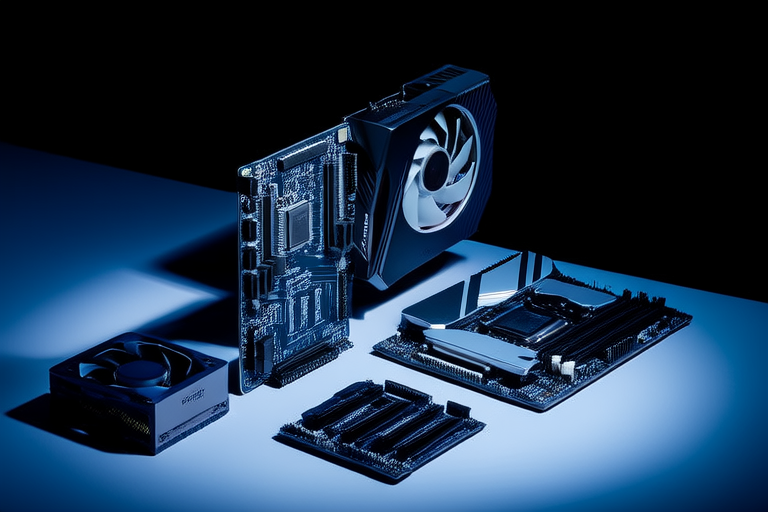“`html
Unpacking the Future: Top Innovations in Computer Hardware
Introduction:
The field of computer hardware is continuously evolving, driven by the relentless pursuit of faster, more efficient, and versatile computing solutions. These advancements are not only enhancing the performance of existing applications but also paving the way for entirely new possibilities in technology. From cutting-edge processors to innovative memory solutions, each development plays a crucial role in shaping the future of computing. In this article, we will explore some of the most significant innovations in computer hardware, examining their current impact and potential future implications.
This article will cover recent advancements in CPU architectures, memory and storage solutions, graphics processing units (GPUs), cooling and power efficiency, and emerging technologies. By the end of this exploration, you will have a comprehensive understanding of how these innovations are transforming the landscape of computer hardware.
Section 1: Processor Technology
Recent Advancements in CPU Architectures:
The central processing unit (CPU) remains the cornerstone of any computing device, and recent advancements have significantly enhanced its capabilities. Multi-core processing and the rise of ARM-based processors are two key areas driving these improvements. Multi-core processors allow for parallel processing, enabling simultaneous execution of multiple tasks, which greatly boosts overall system performance. ARM-based processors, known for their energy efficiency, are increasingly being adopted in mobile devices and even in server environments.
Breakthroughs in Processor Speed and Efficiency:
Advancements in manufacturing processes, such as the transition to smaller nanometer scales, have led to significant increases in processor speed and efficiency. These improvements are particularly evident in the latest generations of CPUs from major manufacturers like Intel and AMD. For instance, Intel’s 12th Gen Core processors feature a hybrid architecture that combines high-performance cores (P-cores) with efficient cores (E-cores), offering both speed and power savings. Similarly, AMD’s Zen 3+ architecture has brought about substantial gains in single-threaded and multi-threaded performance.
Impact on Various Applications:
These developments have profound implications across a wide range of applications. In gaming, faster CPUs mean smoother gameplay and reduced latency, enhancing the overall user experience. In data centers, efficient processors enable better scalability and lower operational costs. Additionally, advancements in CPU technology are crucial for AI and machine learning, where complex algorithms require powerful computational resources.
Section 2: Memory and Storage Solutions
New Types of Memory Technologies:
Memory and storage solutions have seen remarkable progress in recent years, with the introduction of new technologies like DDR5 RAM, NVMe SSDs, and persistent memory. DDR5 RAM offers higher bandwidth and lower power consumption compared to its predecessor, DDR4, making it ideal for demanding applications such as video editing and scientific simulations. NVMe SSDs provide unprecedented read and write speeds, drastically reducing load times and improving overall system responsiveness.
Improvements in Storage Capacity, Speed, and Reliability:
The shift towards solid-state drives (SSDs) has been a game-changer in terms of storage capacity, speed, and reliability. Persistent memory, a type of non-volatile memory that combines the speed of DRAM with the durability of NAND flash, promises to further enhance system performance by allowing data to be retained even when power is lost. This technology could potentially eliminate the need for traditional hard disk drives (HDDs) altogether.
Affect on User Experience and System Performance:
The adoption of these new memory and storage solutions has a direct impact on user experience and system performance. Faster RAM and SSDs result in quicker application launches and smoother multitasking, while persistent memory ensures data integrity and availability. These advancements collectively contribute to a more seamless and efficient computing environment.
Section 3: Graphics Processing Units (GPUs)
Evolution of GPUs:
Graphics processing units (GPUs) have evolved significantly over the years, transitioning from simple graphics rendering engines to powerful processors capable of handling complex computations. Modern GPUs are designed to accelerate tasks that involve heavy mathematical calculations, making them indispensable in fields like virtual reality (VR), cryptocurrency mining, and scientific research.
Recent Innovations in GPU Architecture and Capabilities:
Recent innovations in GPU architecture include the introduction of ray tracing, a technique that simulates the behavior of light to create highly realistic visuals. NVIDIA’s RTX series of GPUs is at the forefront of this technology, offering unparalleled image quality in games and real-time rendering applications. Additionally, advancements in tensor cores, specialized hardware for deep learning, have made GPUs an essential tool for AI research and development.
Impact on Fields Like VR, Cryptocurrency Mining, and Scientific Research:
The impact of these advancements is evident in various domains. In VR, GPUs enable immersive experiences with lifelike graphics and smooth frame rates. In cryptocurrency mining, GPUs are used to solve complex mathematical problems, contributing to the decentralized nature of blockchain networks. In scientific research, GPUs are employed for simulations and data analysis, accelerating discoveries in fields ranging from climate modeling to genomics.
Section 4: Cooling and Power Efficiency
Innovative Cooling Solutions and Power Management Techniques:
As processors become more powerful, the need for effective cooling solutions becomes increasingly important. Innovations in cooling technology, such as liquid cooling systems and advanced thermal paste, help dissipate heat efficiently, ensuring optimal performance. Power management techniques, including dynamic voltage and frequency scaling (DVFS), further enhance energy efficiency by adjusting power consumption based on workload requirements.
Significance of Efficient Power Usage in Modern Hardware:
Efficient power usage is critical in modern hardware, as it not only reduces energy consumption but also extends the lifespan of components. Efficient cooling and power management contribute to longer-lasting and more reliable systems, which is especially important in data centers and other mission-critical environments.
Examples of How These Advancements Contribute to Longer-Lasting and More Reliable Systems:
For instance, liquid cooling systems can maintain stable temperatures even under heavy loads, preventing thermal throttling and prolonging the life of processors. Similarly, power-saving features in modern CPUs and GPUs ensure that energy is used only when necessary, reducing wear and tear on components.
Section 5: Emerging Technologies
Emerging Trends in Computer Hardware:
The future of computer hardware holds exciting possibilities, with emerging trends such as quantum computing components, flexible displays, and advanced input devices. Quantum computers, leveraging the principles of quantum mechanics, promise to solve complex problems much faster than classical computers. Flexible displays, featuring bendable and foldable screens, offer new form factors for devices, enhancing portability and usability. Advanced input devices, such as haptic gloves and eye-tracking sensors, provide more intuitive and immersive interactions.
Potential Future Implications:
The integration of these emerging technologies could revolutionize computing as we know it. Quantum computers may unlock new frontiers in cryptography, drug discovery, and optimization problems. Flexible displays could lead to the development of wearable technology and interactive surfaces. Advanced input devices could transform human-computer interaction, making it more natural and intuitive.
Speculation on How They Might Revolutionize Computing:
While still in their infancy, these technologies hold the potential to fundamentally change the way we interact with and utilize computing devices. As they mature and become more widespread, they could redefine industries and create entirely new markets, pushing the boundaries of what is possible in technology.
Conclusion:
Summary of Key Points:
In this article, we have explored some of the most significant innovations in computer hardware, including advancements in CPU architectures, memory and storage solutions, graphics processing units (GPUs), cooling and power efficiency, and emerging technologies. These developments are not only enhancing the performance of existing applications but also opening up new possibilities for the future.
Broad Impact on the Tech Industry and Society:
The broader impact of these innovations is profound, influencing not just the tech industry but also society at large. Faster and more efficient processors, improved memory and storage solutions, and advanced GPUs are driving progress in fields ranging from entertainment to scientific research. The emergence of quantum computing, flexible displays, and advanced input devices promises to further expand the horizons of what is achievable with technology.
Forward-Looking Statement:
As we look to the future, it is clear that the pace of innovation in computer hardware will continue to accelerate. New technologies and breakthroughs will undoubtedly emerge, reshaping the landscape of computing and unlocking previously unimaginable capabilities. The future of computer hardware is bright, and we can expect to see even more transformative changes in the years to come.
“`


